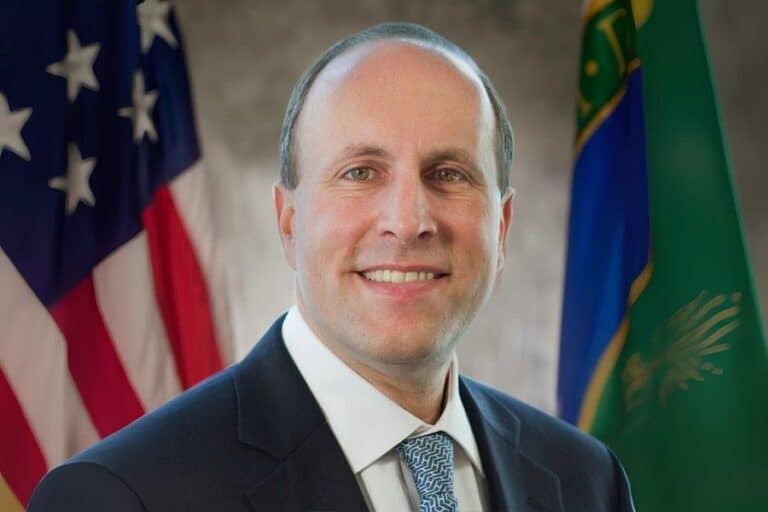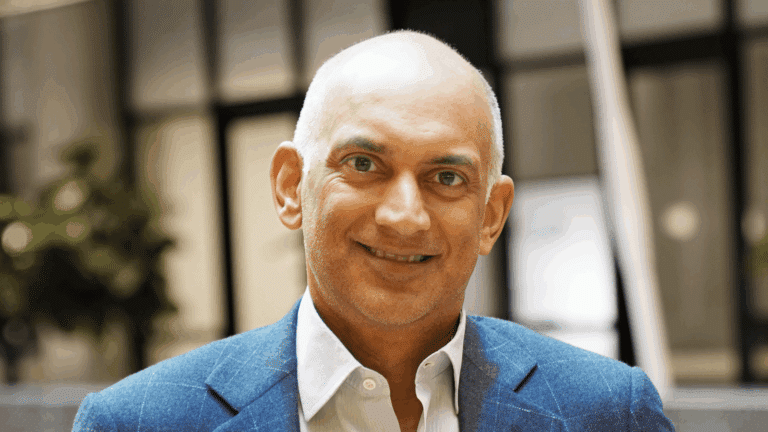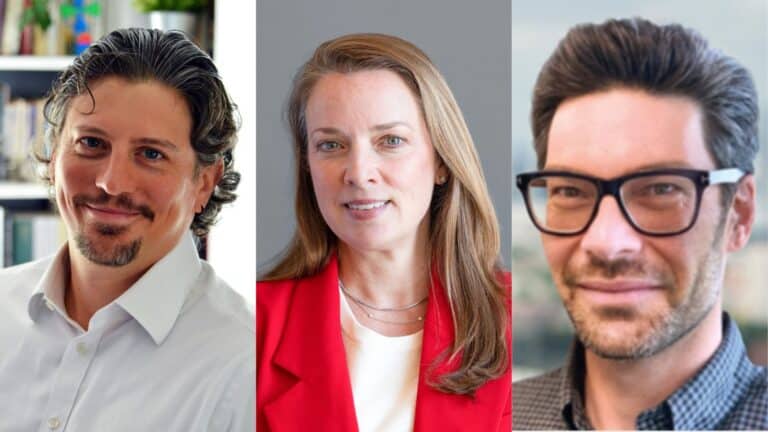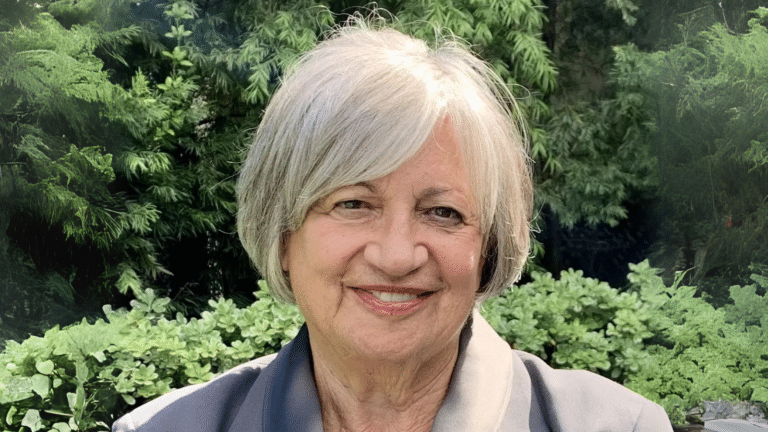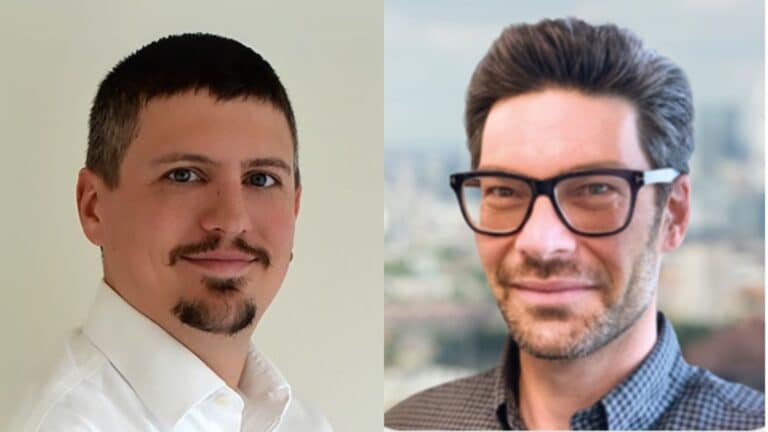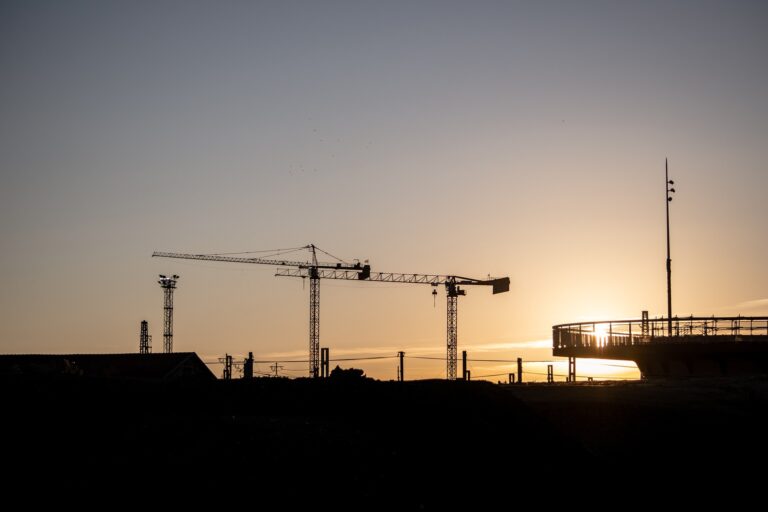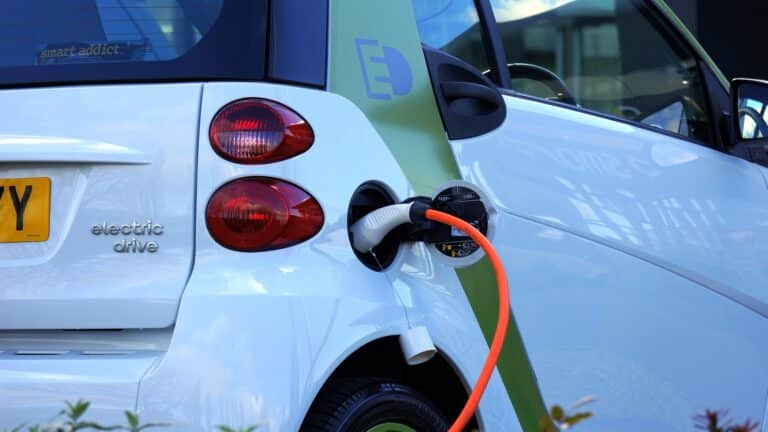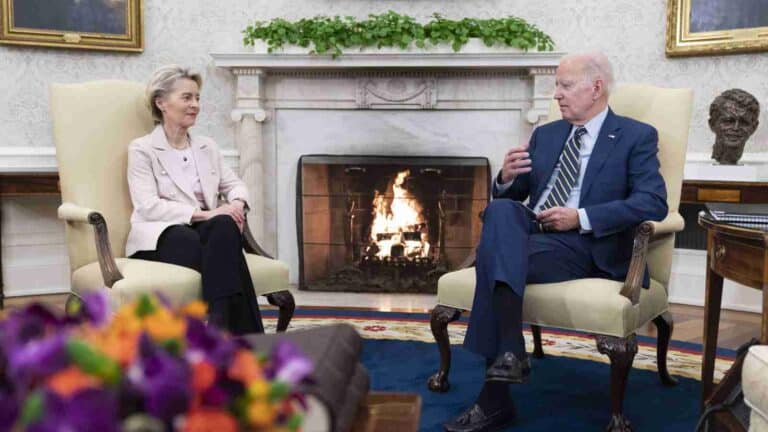Arun Majumdar: I think we need to think about our students having a foothold in a foundation in one field, whichever that is, and an understanding of the actions that humanity takes on sustainability issues and climate as well as energy, water, et cetera.
Jason Bordoff: Global clean energy investment has risen by 40% since 2020, reaching an estimated $1.8 trillion last year. According to the International Energy Agency, nearly twice the spending on fossil fuels. The cost of many types of clean energy has been falling rapidly, often competing favorably now with fossil fuels, thanks to technological advances and innovation. But the world still isn’t on track to reach its emission reduction targets. And now new forms of demand such as data centers and AI are creating concerns about rising energy use and emissions. So how do we encourage more innovation in clean energy? How do we mobilize investment to scale up and commercialize emerging technologies? What’s the role of the private sector and what kinds of policies do we need? And finally, how can higher education adapt to provide the knowledge and the skills needed in the clean energy economy?
This is Columbia Energy Exchange, a weekly podcast from the Center on Global Energy Policy at Columbia University. I’m Jason Bordoff. Today on the show, Arun Majumdar. Arun is the inaugural dean of the Stanford Doerr School of Sustainability. He also serves as the Jay Precourt Provostial Chair Professor at Stanford, and senior fellow and former director of the Precourt Institute for Energy. Formerly, he served as a vice president for energy at Google. In the Obama administration, he served as founding director of ARPA-E, the Advanced Research Projects Agency for Energy, and as the acting undersecretary of energy. He also served as a science envoy for the U.S. Department of State, and currently serves as chair of the U.S. Secretary of Energy Advisory Board.
Arun and I discussed a range of topics including his childhood in India and his work at the Department of Energy. We also talked about his new role at Stanford and some of his views on emerging technologies and on energy policy. I hope you enjoy our conversation.
Arun Majumdar, wonderful to see you again. And thank you for making time to be with us on Columbia Energy Exchange. I know how busy you are and really grateful for your time.
Arun Majumdar: Great to be here.
Jason Bordoff: Where do we find you now? On the Stanford campus, I assume?
Arun Majumdar: Yeah, this is Stanford Campus.
Jason Bordoff: Tell me, and tell our listeners, I want to start by talking… We’ll come to what you’re doing at Stanford now in the new Doerr School and how exciting that is. I want to start by just making sure our listeners know about you and your background. I’ve heard you talk before about your upbringing in India and how that affected the way you see the world, how you see the importance of energy, the role energy plays in people’s lives, the role pollution can play in people’s lives if we don’t get some of these problems right. And I was just wondering if you could talk a little bit about your background and how that came to view the way you see these issues today.
Arun Majumdar: Sure. I was born in Calcutta in the sixties, grew up in Delhi, went to a boarding school in the state of Rajasthan called Mayo College, and then went to my college in Mumbai, which used to be called Bombay, and it’s the Indian Institute of Technology Bombay. So till 22 years old, I was in India, and I came to the United States in 1985 as a graduate student with two suitcases. And those years, the early years were formative years. They make a big impression on you, on how you grow up and your friends and your community that you have. And on the energy front, there was an energy crisis in the seventies. The whole world faced the oil embargo. Renewables got highlighted at that time, got really underscored that this is going to be important, but the cost was too much.
I still remember traveling by trains. I never flew a plane until I came here. So it’s mostly all the travel is by train out there between cities. And it’s coal. It’s coal based steam engines that used to run, then became diesel, and then became electric. And that was a big deal because if you’re running in a coal… If there’s a coal engine in front of the train and you can’t close the windows out there because it’s hot, by the time you travel for a day and a half or so, you’re kind of black. And you shower and all the coal dust comes off. And when it became electric, it was great. At home, my mom used to cook on a coal stove. That was the cheapest fuel and there was no gas pipes that were coming to homes.
And then we switched to gas cylinders, the LPG cylinders, and that was a big deal because it was cleaner. And so my early life was an energy transition that we saw happened. And there was a huge demand for gas cylinders. And sometimes, we had to wait. They were rationed out. Talking about rationing, when I was growing up in India in the 60s, 70s, there was food ration. Because the Green Revolution, the one that Norman Borlaug started, these were early days. And rice and wheat and sugar and cooking oil, they were all part of the ration. So I saw that. And then India became food independent. Now it’s an exporter of food. So technology playing a role. And the transition and food security and the energy security issues, we grew up with that.
Jason Bordoff: I mean the reference to Norman Borlaug, you’re saying you saw the role innovation and technology could play in solving a problem like food for a rapidly growing population.
Arun Majumdar: Exactly.
Jason Bordoff: And you see something similar now playing out for how we think about meeting the rapidly growing energy needs of billions of people around the world who use just a fraction of what we all take for granted. That’s the comparison you’re making.
Arun Majumdar: That’s exactly right. Yeah. So we think that we are suddenly in an energy transition. It has been going on for a while, and it’s going to go on for a while. These things don’t happen overnight. And I think one has to obviously take some short-term issues that are very important, but also it’s important to take the long view because there are eight billion people in this world that’ll have to go through that. And if that does not improve the quality of life for people, those eight billion people around the world, it’s not going to fly.
Jason Bordoff: And so in the conversations you are having, whether it’s on the Stanford campus in New York, in more developed economies about where we are in the climate crisis, how to address it, what this energy transition looks like, how does the view of those billions you just talked about, how does it shape the way you think about the role of different technologies, of different fuels, the pace of transition and how it’s different maybe in different places around the world? Because these numbers are really big when you’re talking about meeting, not just charging cell phones or powering light bulbs, but real industrialization, economic activity, mechanizing agriculture. These are big numbers. How do you think about that?
Arun Majumdar: Yeah. I mean, you have talked about it so many times on energy security, economic growth. I mean, I always call it a three-legged stool, that when you’re talking about the energy transition, it has to be about energy security. There’s an economic growth aspect. People are not going to suddenly change and forgo the economic growth because of an energy transition. In fact, it has to be part of the energy transition is the economic growth. And there’s the environment and climate. Now, one needs to think about it in timescales. When there’s a Ukraine war, there’s a short-term energy security issue that one has to address.
There’s a mid to long-term issues which one has to do. And the question one has to ask is, how do you harmonize what you do in the short-term with the long term? And those are not trivial. So anyway. So I think anything that we do in the short-term that increases carbon emissions for some reason has to be compensated in the long term with additional, the greenhouse gas removal, or some other ways of addressing, accelerating the transition to clean energy, et cetera. So I think the harmonization of those short to long-term policies are very, very important.
Jason Bordoff: Do you think there’s trade-off when we talk about decarbonization and energy for development, the billions you were just talking about? I mean, you often hear many people, I’m sure you hear it too, saying, “This is going to take a long time. We have to go slower. You can’t do it all with renewables and we’re going to need fossil fuels for a long time because there are so many poor people around the world.” Or is that just an excuse for inaction?
Arun Majumdar: I don’t think so. I mean, obviously any decision you make, there are trade-offs. But if you take the long view again, take a country like India, it imports most of its oil. And that oil is used mostly for transportation. And whether we like it or not, it is an energy security issue. And so if it can move its light-duty transportation… The trains, the locomotives are already electric, but if it can move its light-duty transportation to electric and electricity is locally developed, it actually adds to the energy security.
And most of the people in India on roads travel by two and three wheelers, which are much easier to electrify than SUVs. So I think this is a imperative that it’s an energy security driven imperative, just like renewables in the seventies was a security driven imperative to go to renewables. I think the same thing out here. So I think they can be harmonized. And transition to renewables or nuclear for that matter, it’s an energy security issue, as much of it’s a climate issue.
Jason Bordoff: Yeah. I mean, as our regular listeners know, the only way I get around New York is an electric two-wheel vehicle. But don’t you think for most people in the world, moving from two and three wheel to four wheeled is the ambition, that is progress?
Arun Majumdar: Absolutely.
Jason Bordoff: Yeah. So that is the challenge we have to confront.
Arun Majumdar: Yes.
Jason Bordoff: How to deal with those rates of economic growth and what it means for energy demand, and then therefore, what it means for the ability to do this with zero carbon energy.
Arun Majumdar: Well, you could say that’s one signature of progress, but it’s very cultural. I mean, going from a two-wheeler to a car may seem a increase in their own self-image, et cetera. But frankly, if you could improve the self-image of public transportation, that would be the right way to do it. In fact, you don’t have to wait in congested roads, et cetera, which many of the big cities like London and others have done.
Jason Bordoff: Yeah. I would’ve liked to have seen our governor put congestion pricing in place. But yeah, it comes to those concerns about energy affordability even in developed economies, and the price of this transition, and the populist backlash we’re seeing in certain European countries and anger about the cost of energy rightly or wrongly connected to a sense that this is somehow about an energy transition and climate policies.
Arun Majumdar: And that is true for… Even cultural aspects are true even for food. In fact, food is so cultural, so much more. And as you know, the global emissions from the food and ag sector is more than transportation. It’s 25% versus 14 or 15%. Right?
Jason Bordoff: Right.
Arun Majumdar: And so that, the cultural aspects of it are really, really important.
Jason Bordoff: Let me ask you about coming back to the role of innovation and what role that can play in climate action and the clean energy transition, and maybe again walking through your career. Because you started in the private sector and you spent a lot of time, for example, at Google. How do you think about the role of the private sector today and private capital in this energy transition and how can it best be deployed in partnership with governments to accelerate the pace of clean energy?
Arun Majumdar: I think from the private sector right now, we have about, let’s say 60 plus percent of the Fortune 500 companies have made some kind of a climate or net zero commitment, which is terrific. But if you ask the question, how many have figured out a way to navigate that, the answer is very few, if any. And so I think these are early days. And the commitment is very important. But commitment also means resources because this will require capital. So I look at corporations in, I would say, roughly two categories. And these are not fixated, hard-nosed, different, distinct. But there are companies in one extreme who look at it as a compliance issue. “Hey, we have to do an ESG and compliance issue.”
There are other companies that are looking at this as a business opportunity to make money, as capitalism. And I think those companies that are looking at this business opportunity are positioning themselves early in the game where we can leverage this opportunity. So I think those companies are, if they position themselves wide, if they get access to the capital, low-cost capital, they will transition. And I’m not talking just about U.S. companies. I mean, I’ve been interacting with global companies and many of them see this as an opportunity to transition, because energy is so fundamental as you know very well.
It’s a hundred trillion dollars economy and that’s going to grow. We want it to grow. And the whole economy needs to transition to a different energy. So that is, I think, a lot of companies. And we obviously want to interact with those corporations and provide some value out there, whether it’s talent that we produce at universities, or new ideas or innovations, or cross-sector dialogue, which is very, very much needed.
Jason Bordoff: We’ll come back to some specific energy-related companies, the ones using huge amounts of energy or certainly energy producers because there’s certain challenges there where you get the billions of dollars for first-of-the-kind demonstration projects and all of that. But for the corporate sector as a whole where energy is not the day-to-day business or very energy intensive products, how do you think about what they are doing, what they should be doing to best advance this work? The traditional strategies we’ve seen like buying offsets or renewable energy, virtual PPAs, these are kind of increasingly getting called into question maybe as greenwashing, that you’re making promises but you’re not really changing anything.
But then when you start to talk about scope one, two and three emissions for these companies, in most cases, that’s just a drop in the bucket compared to the global emissions problem, and you might be double counting things in different places. So how should companies think about their role in this work, broadly speaking?
Arun Majumdar: Yeah. You mentioned Google. Yes, I did work at Google. At Google, which is now leaning into AI like many other large tech corporations, energy is a big deal. The whole growth of the AI data centers sector, energy could be the limiting factor. And we just finished a SEAB report on AI powering data centers.
Jason Bordoff: The Secretary of Energy Advisory Board.
Arun Majumdar: The Secretary of Energy Advisory Board.
Jason Bordoff: Which you chair, just so our listeners know.
Arun Majumdar: Yeah, that’s right. We just finished a report. And this is how do we power AI data centers. Because energy could be the limiting factor out there. Because the growth of electricity demand that we are seeing, the utility sector, the electricity sector had never seen this kind of demand growth. So I think energy is fundamental even for the tech sector. And if you look at the value that they create from the electricity, the value from AI is much, much higher compared to the price of electricity. And this industry wants to do the right thing. They want to use clean electricity.
So I think here’s an opportunity that if you really want to power the data centers of the future, and they’re willing to pay maybe a little bit more because the price is insignificant compared to the value, here’s an opportunity to perhaps then use a private public partnership with the government to try out and do demonstration of innovative technology, whether it’s storage or small modular nuclear or much lower cost and higher, more advanced renewables. So I think that’s the opportunity out here that we see, and I think we should take advantage of this.
Jason Bordoff: Just out of curiosity, because I suspect some people listening may have heard that renewables are just the cheapest form of electricity now. So when you say companies need to be willing to pay a little more, talk about why that is and what you see in terms of the reality of what it looks like to put a lot more green electrons on the grid.
Arun Majumdar: Yeah. I mean, renewables are the cheapest way to produce electricity in many parts of the world. They have to be moved by transmission lines. And those transmission lines are difficult to build nowadays because of various regulatory and community issues and all of that. So I think, in addition to development of renewable infrastructure, the transmission lines, the infrastructure for that is super important. As you have more and more penetration of renewables on the grid, there are other challenges that come up. The grid architecture and the architecture today and the whole paradigm is still the Tesla-Edison architecture. And that was not designed for renewables to be there, or fluctuating generation.
So at some point, we’ll need storage. Now, storage costs money. And so the balancing of the grid, the reliability of the grid today is by natural gas. And so there are various options now. You could add storage, electrochemical or thermal storage in the grid, or you can use natural gas. And if you want to decarbonize, do carbon capture or use renewable methane, renewable natural gas. And so those are the options. And I think will have to compete to play it out. And my sense is that I think different technologies will be used in different locations because many of them are location-specific. The infrastructure is location-specific.
So I think that’s what is going to play out in the future. In terms of paying more, any new technology that comes on board initially is more expensive. And then if you do more and more, you learn and you go down the learning curve and reduce the cost. Which is why many of the new technologies, as you know very well, is subsidized initially. And eventually when it’s competitive, market competitive, the subsidy should go away. Sometimes it does, sometimes it does not. So I think there is a public-private partnership out here between the government providing some incentives and the private sector investing and so that any new technology can be brought down in cost to make it competitive.
I mean, when I was in Google, we launched a prize called the Little Box Challenge which came from my group, and this is on power electronics. And the whole idea of wide bandgap power electronics, which is really important for data center, it’s also important for a grid. And that was too expensive. So the challenge was to essentially elevate the whole sector and use a competition to bring down the cost, and thereby get things started, get things catalyzed.
Jason Bordoff: You talked about grid reliability, and I think you see more and more grid operators and regulators raising concerns about the state of the grid today. As you said, it’s an old creaky system of wires combined with more intermittent sources of energy, retirement of coal, and in some cases, nuclear that runs all the time, the physical impacts of climate, severe weather, rising demand. Do you share that concern about the reliability of the U.S. electricity system, which we mostly take for granted? When you flip the lights, they’re supposed to go on. And what do we do about that?
Arun Majumdar: Yes, I do. I do worry about that. We had many sessions in the advisory board on this particular issue. Just going back to my comments before, the architecture is the Tesla-Edison architecture, the paradigm. The devices can be new. There are new transmission lines, new transformers, substations, et cetera. But the architecture is still the same. And the architecture is not built for solar and wind. So we need to address that. So I think the reliability comes from many, many different sources. One is, the more you install solar and wind, you’ve got to have some kind of balancing act. Because solar is predictable because you have sunrise and sunset. And generally, you put solar farms in places with the sunlight.
And I know that people put rooftop solar in San Francisco. Well, that makes them feel great. But most of the solar is in desert regions weather. Wind on the other hand, obviously put the wind resources where it’s windy, but it’s not as predictable. So many places where there’s high penetration of wind, like in Texas, and Texas grid as you know is an isolated or caught as fairly isolated, not completely. And there are challenges when you are predicting wind to be so much, so many megawatts, and it’s not quite there. And that creates challenges on the grid. And which is why storage then becomes, or natural gas supply becomes very, very important. So that’s one source of reliability issue. The other one is… Yeah, go ahead.
Jason Bordoff: I was just going to ask about the storage piece, because people often look to how much battery costs have come down, and that can store renewable electricity maybe hours. But when you talk about weeks and months, it gets a lot harder. So talk about the role storage plays when you’re not just talking about day to day.
Arun Majumdar: So storage is of different timescales, right? If you have, let’s say, 30, 40% penetration on solar when in a regional grid, you need daily storage, but not weekly storage. And the daily storage can be done with lithium ion batteries, which is being installed. And that’s hugely important because it takes away… In fact, in California grid, that storage is critical for its reliability. And there’s a lot that has been installed. And the same thing is going on in Texas. As you get to more and more penetration of renewables, and you will need longer, longer storage, and in few times a year, in less number of times per year.
So the capital cost of that storage has to be much lower than lithium ion batteries. In fact, the estimate is that, if you really want to get to penetration of 60, 70% renewable, your storage CapEx has to be 10 times lower than lithium ion battery. Lithium ion batteries roughly fully installed is about $300 a kilowatt-hour. And that has to be less than $30, maybe $10 a kilowatt-hour. Those storage solutions are not yet here today except for pumped hydro. Pumped hydro is really the cheapest way to store. And most of our storage today is in hydro.
And so those technologies, some of the things that we had invested when I was in ARPA-E are now coming to the point of demonstration, pilot demonstration. And I would say, in the next five to seven years, by the end of the decade, you’ll start to see things going at scale. When the cost has come down, it’s going to demonstrate de-risk, and the capital invest will come in. So I think these are early days for long duration storage.
Jason Bordoff: And it’s the right way to think about what you just said. When you start to get to 60, 70% penetration, and then daily storage, lithium ion batteries that can do a lot of the work, but there are these small periods of the year where that’s not going to be enough. You mentioned natural gas a moment ago. If you think about, until… Eventually, we want net zero as the goal. But if natural gas is playing that role now, people listening might think, “Well, we can’t do that because we have a climate crisis.” But do I hear you correctly saying the emissions from that kind of system are actually quite small because, as long as you have an economic model that makes sense for someone to keep a plant on standby, you’re firing it up a few times a year, but your zero carbon system is doing most of the work most of the time, and you’re getting reliability from a fairly small amount of emissions from whatever gas plant you’re using. Is that the right way to think about that trade-off?
Arun Majumdar: Yeah. I mean, we will be using gas. Today, it’s really the source of reliability in many parts of the country. And we’ll be slowly transitioning off gas. It’s not going to happen overnight. And at some point, it’ll be uneconomical to put new gas plants. And we are hoping that the cost of storage, the long duration storage will come down fast enough that storage becomes the solution as opposed to gas. In the interim, there will be gas used. And the question we have to ask is, how do we manage the carbon emissions for that? Now, there are multiple ways. You can have renewable methane or renewable natural gas, and then becomes the net zero. You could also use carbon capture and sequestration or utilization of that. That’s another way to do that. And so I think those technologies, those innovations will have to compete. And I think economics will dominate this.
Jason Bordoff: Can we come back to AI? You were talking about the SEAB report a moment ago and what it found and what you see. The numbers seem to me to be all over the place for how much the growth in AI and data centers is. And we barely understand this technology yet, what the use cases for it will be. And people have projections with huge anticipated growth in electricity demand. On the other hand, the technology gets more efficient, the Nvidia chips get more efficient. I remember end of the 1990s, lots of projections that the internet revolution would cause electricity demand to go through the roof and that never happened. What’s your sense of what this is actually going to mean for electricity use in this country?
Arun Majumdar: That is a great question. So we looked into that. We talked to people at all the big AI businesses, AI related businesses, as well as the electricity sector, et cetera. And there’s a fair bit of speculation going on. What people are underestimating, as you pointed out, is the energy efficiency you can gain not only from the chips becoming more efficient, but also the algorithmic ones. And the algorithms… This is public knowledge. I think Google announced it. They were able to get 100X efficiency for the same job, for the same computing power, 100X reduction in energy in two years. And this is purely by the algorithms that you use, whether how do you do matrix inversion, et cetera.
And there’s still room to go. There’s plenty of room at the bottom, as Feynman had said, in this case. So I think you will see progress in that. Now, as soon as you… Here’s the Jevons paradox also, which says that, the more efficiency you get, the more you will use. And so there’s some uncertainty as to how much of that actual growth, because there are two competing things that are going on right now. And it’s unclear what’ll happen. And as you know, many of the algorithmic work that is going on is proprietary. And we don’t know what’s going on. So one of our recommendations to DOE is to create a AI focused test bed, a user facility for the public good so that people in universities or national labs and others or even corporations can try out new algorithmic solutions, new algorithms, and test their energy efficiency.
And I think this is going to be really, really important. And that’s the best thing about the United States. It’s open. And that public database or public test bed I think is going to be critical.
Jason Bordoff: For the reasons you talked about before, it’s really hard to permit and cite things. There’s a whole permitting reform debate obviously happening. A new proposal now that has come up. So you talked about the challenges with citing and building the transmission lines one needs for dramatic increases in renewables. Nuclear technology is progressing. I want to hear more from you about that, but it takes time. If we need a lot more electricity in the next couple of years, say two to three years, is that inevitably going to be natural gas to meet the growth in data centers and AI, or do you see an alternative in the timescale we need?
Arun Majumdar: I think, in terms of cost and the investment trends that we are seeing, it’s going to be a combination of renewables and natural gas. Renewables are cheap right now. And as you know very well, and we were in Davos together, one of the data that the head of IEA provided that we have $2 trillion investment in renewables last year compared to $1 trillion in fossil investments. This is global. So clearly we are seeing the transition going on in that because costs have come down. So I think those are the… But again, for reliability purposes and even for some of the base load purposes, we’ll see natural gas. And that may grow. And that’s now the trade-off now, right?
Do we not do natural gas and let some of this data centers go overseas, which is a national security issue, or do we put some natural gas now and then figure out how to manage the carbon? While we develop the renewables… And as you said, the first nuclear plant, ASMR, if you have to do this, will probably be 2030 onwards. And so that’s going to take some time. So that’s the trade-off stuff.
Jason Bordoff: Yeah. And that last point is a really interesting, one we’re spending time on, and it was a big topic of discussion at the Aspen Security Forum this year. If it is really hard to build this additional electricity here, people need places for data centers. And you have today countries, say in the gulf, with a lot of money to throw at the problem and green electricity. And is it a national security concern? Should it be? Will companies like Microsoft, Google, others want to go build those in places like the UAE and Saudi? And will U.S. policymakers have a problem with that? What does that mean for Chinese technology and the role it plays in different parts of the world?
We saw that, I guess, with Microsoft and G42, this deal that the U.S. Commerce Department was involved in helping to broker recently, but is under review again now. Do you see a national security… Did that come up in the work SEAB did, how to think about data centers in different parts of the world and the role Chinese technology plays in them?
Arun Majumdar: Well, that was certainly the reason why the secretary asked us to look into it. And the job of the SEAB, the Secretary of Energy Advisory Board is to really help the secretary and her team answer some questions that they need help in. And she asked us this question. I said, this is a national security issue, and we all agree with that. And the question is, what do we do? And that led to some work, some pretty intense work with the information, the tech industry as well as the electricity industry. And I think the DOE can play a very important role, and this is a role that only the government can really play is to bring two different sectors together and say, okay, let’s figure out what do we do? What’s the interoperability standards that we need to create so that data centers can provide services to the grid and vice versa? The reliability that is needed for training of algorithm, not the inference part, but the training, doesn’t need to be five nines.
You can have a power outage and they can store the data and restart the training algorithms. And again, of course, there’ll be huge jumps and spikes in power. So this is a very different ball game. Now on the inference part of AI, which is where you query something and someone you need an answer, ChatGPT giving a poem of some kind, let’s say, and that’s real time.
Jason Bordoff: Or giving me a script of questions to ask Arun Majumdar, for example.
Arun Majumdar: There you go.
Jason Bordoff: Hypothetically, right?
Arun Majumdar: That’s right.
Jason Bordoff: What do you see, what will the role of these big tech companies, Microsoft, Google, Amazon, et cetera, be? Are they becoming energy companies? Are they going behind the meter and going to build their own power plants? What approaches do you see them taking right now?
Arun Majumdar: We heard quite a bit of that, whether they will be behind the meter. They will be behind the meter assets they’ll have. I mean, they have it today. Diesel generators. Right? So they don’t want to do diesel generators, so storage will come in. So I think there will be a combination of behind the meter and of course the grid related one. And there was a lot of discussion reconductoring lines to increase the capacity of existing power right aways. And that could go a long way. There was a study from LBL, Lawrence Berkeley National Lab, that actually looked at what could reconductoring do. And the percentage of demand growth and the reliability requirements, et cetera. It’s very high. And so I think, if I remember right, like 80% of the demand growth can be addressed.
So even if you don’t believe in that number, let’s say, but it’s high. It’s certainly in a more than 50%. So I think these are the kind of technologies, and the permitting is going to be much easier. We’ve got to look at it holistically. Innovation in technology, innovations in regulatory approvals and measures. And some of the things that we will be now looking at SEAB, whatever time is left, is how to use AI to actually accelerate the permitting and siting processes.
Jason Bordoff: Yeah. We’ve done some work on that here. And I think there’s a lot of opportunity for you to help accelerate improvements in efficiency, putting more electricity through existing lines, advancing clean energy, predictive weather modeling to get more from renewables, et cetera. Coming back to the role of innovation and how we scale up innovation into commercial application, what you see as the most promising approaches for mobilizing investment in the scale up and commercialization of emerging technologies. Because there’s a valley of death, a missing middle between VC investment in the early stage and then finance for mature infrastructure investment. How can companies raise capital for first of a kind industrial manufacturing facilities for next generation batteries or the first five commercial scale, long-duration storage systems, et cetera?
Arun Majumdar: Well, I think it’s a question of risk. And the question is, can you de-risk fast enough? Because while we want innovations to come in, if you talk to an investor who wants to invest, like you need a billion dollars to do a demonstration plan of some kind, that’s risk. And the question is, are there mechanisms that we can put in place that can de-risk fast? So about, let’s say, eight years back, a few of us wrote an article, John Deutch, myself, George Shultz and Norm Augustine on how to create this private-public partnership. And I think it’s very important. And this is where the government can play a role is to bring a sector together, maybe along supply chain, in a competitive way, and ask the question, “Okay. Can 10 companies put $10 million per year for 10 years?” Right? We call it a 10-10-10 model.
And the government can put that small amount of money that will be needed to catalyze this. But it needs to be private sector driven. The government can play a role. But the private sector driven means that after that process, it can actually become bankable. And I think that’s the kind of things that we need to figure out. And some of it is in the hubs that we are now seeing. But the hubs need to lead to bankability commercial efforts, that investors would come in and say, “I’m going to get returns on this.”
Jason Bordoff: What do you see as the role of the traditional energy companies, the oil and gas companies, in these clean energy technologies, the role for research, the role for partnerships with the universities and funding. That’s a controversial issue on the Stanford campus as it is on the Columbia campus. What do you see happening in these companies? And for some, the only way to make progress is to keep them away from it all and they’re going to be a barrier to progress. And for others, they have the budgets and the engineering expertise, the project management skills to advance this. How do you see that question?
Arun Majumdar: Well, I’m not in a traditional fossil fuel company, so I can’t say exactly how they’re thinking. But I suppose there are some short-term things that they have to do. They have to show returns, financial returns. And that will obviously largely be based on fossil fuels today, because they’re a fossil fuel company. That’s what the shareholders expect to do. What I’m hoping that they do is to also take the mid-to-long-term view. And the question is, do they remain as fossil fuel companies and want to be that way, or are they open to transitioning themselves and becoming a broader energy company? And so I think that’s the question they have to answer. The board members, the shareholders have to ask the question, and they have to respond to that.
The shareholder viewpoint is quite different in Europe, as you know, than out here. And I think they’ll be responding accordingly. So I think it really goes to the core of, are they going to change or not? This reminds me of a very nice book, very famous book that was written by Andy Grove called… Andy Grove was the CEO of Intel, famous. Intel almost went under in the late eighties and nineties because the Japanese competition on memory chips. And they had to pivot. And the book was called Only the Paranoid Survive. And I think this is something that all the oil and gas companies need to think about the long-term as well, and whether they will… And I think different companies will respond to different signals based on the shareholders, the policies, et cetera.
Jason Bordoff: Yeah, yeah. Well, you mentioned the difference between the U.S. and Europe. And we see some of the European companies seeming to pivot maybe in the other direction because of those near-term shareholder pressures and exactly what the profitability of some of these strategies looks like in the near to medium term versus the long term. Let’s come to what you’re doing now, because we only have a few minutes left. So talk about the Doerr School and where you are now, the evolution of it, what the school looks like. What does it mean to build a school of sustainability, and what’s the role of higher education in addressing all the challenges we just spent 45 minutes talking about?
Arun Majumdar: Well, we are two years in into a new school, but it was five years in the making. So these things don’t happen overnight. It’s the first school Stanford has launched in 75 years. And it’s among six other schools, engineering, medicine, business, law, humanities and sciences, and education. If you look at the issue of sustainability, which is not just energy but it’s, what happens in energy affects water. What happens in water affects food. What happens in food affects biodiversity, it affects ecology, it affects public health. And climate change aggravates all of it. Right? And if we look at it holistically, this is not just an engineering issue or a science, it’s not just a business issue, not just law issue. It’s all of the above.
So universities are not structured, or the organization of the university doesn’t quite fit the model of an issue of this magnitude and scale, this urgency, and this complexity. So the question is, why did we start a school? Well, we have to start something at the biggest scale we can with the understanding that school is the biggest thing we can do, but it’ll have to be different. And the way we are looking at this, and in fact it was written in all the documents that we had, this needs to be an all-campus effort. So we have been given the responsibility and the stewardship of providing the service to our students, to our faculty across the whole campus, and to create this all-campus effect. And we have all kinds of mechanisms in place organizationally to create this all-campus effort.
Jason Bordoff: So does that mean, if you want to spend your career working on these issues, you get a degree from the Doerr School, or does it be in the law school and the business school and the engineering school? Everyone’s going to be operating differently. Or is that just not the right way to organize a university to tackle these challenges? The historic, over centuries, we developed a discipline of law and a discipline of business and a discipline of engineering. We have to stop thinking that way. Is that what you’re saying?
Arun Majumdar: No, those are very, very important, because you need the depth of understanding of the engineering issues, of the legal issues. That is what our strength is, because you need that depth of understanding. So let me give you an example of what an all-campus effort looks like. When we launched the school, just internally, we were given the option, people were given the option, do you want to be joint with the school? So we have a total number, just headcount, of 140 faculty members. Half of them are joint. And we have joint appointments with every other school. This is the first time it’s actually happened. I’m a joint. I’m the dean of the school. I’m a joint appointee with school of engineering. And half of my colleagues are joint appointments like that.
And so what that does? It creates a microcosm of the whole campus, and those who want to lean in to sustainability. Now, there are many people who want to lean into sustainability or getting more interested in this area, whether it’s in chemistry or in education or in medicine. There’s a huge amount of interest. But they’re not faculty in the school. So what do we do then? Well, we have mechanisms, like we have two institutes, the Woods Institute for the Environment, the Precourt Institute for Energy, and we’re going to launch a third institute. And the role of the institute is to create a connective tissue across all campus to bring faculty and students together to do solutions-driven research.
And those institutes were not part of any school earlier. They used to report to the dean of research, vice provost and dean of research. Now they have been brought under the school to provide the stewardship on behalf of the school, but also to bring that all-campus effort into the school for research purposes, solutions driven research. And then we have something called the accelerator to actually curate to think about scale, show proof of scalability and launch these solutions. And these call for proposals and all the workshops are an all-campus effort.
The education that we’re developing right now, the curricula, undergraduate and graduate, is an all-campus effort. We open it up to everyone on campus. And so I think that’s the kind of spirit that we have is to create this all-campus effort, because otherwise, we’ll be too siloed and we will have unintended consequences that I don’t think is the right thing to do.
Jason Bordoff: What skillsets do you think students entering universities today should be learning to make careers in clean tech?
Arun Majumdar: So they can have a degree in economics, for example, or a degree in mechanical engineering, which is my other department. But I think what they need to know is, how does that fit to areas of energy or water, of food, biodiversity, et cetera. So I think the connections, I really hope the students get not only the foundation in their own discipline, but also in the process, before they graduate, learn about aspects of how are they all interrelated, what does it imply on the humanity if they take any action, or planet or climate, implications of this. So I think we need to think about our students having a foothold in a foundation in one field, whichever that is, and an understanding of the actions that humanity takes on sustainability issues and climate, as well as energy, water, et cetera.
Jason Bordoff: We will not have enough time for the last thing I wanted to talk with you about, which is your view on a range of emerging, our next generation technologies. And I had written on my list here, fission, fusion, geothermal, carbon capture, direct air capture, hydrogen, including geologic and natural. I’m curious about that. So we don’t have time to go through all of those. But maybe from that list or something I didn’t think of, which of those are you most excited about given what you see happening right now, and maybe which do you think is most overhyped right now?
Arun Majumdar: Let me talk about greenhouse gas removal from the atmosphere. I think this is absolutely critical. I think the chemical direct air capture, I say this openly, they will not scale unless you find 1000 terawatt hour zero carbon heat at two cents a kilowatt hour, because we don’t have the energy infrastructure to be able to manage that through chemical means of separation. And there’s some basic laws of physics that says that. On the other hand, if you use agriculture, if use ocean, alkalinity in the oceans, or use crops to remove CO2, use the crop waste to create biochar, those are the kinds of things that we should be thinking about. And I think that’s just one example. I’ve slowly become a big fan of geologic hydrogen.
Jason Bordoff: Yeah.
Arun Majumdar: We just published an article on hydrogen. The title is called The Requirements for Scalability of Carbon-Free Hydrogen. And if you look at electrolytic hydrogen, not that it will not grow, it will grow, but if you want to meet the demand of hydrogen from purely electrolysis, you’ll need an entirely new grid to be able to do that. Right? And the same thing in a steam-methane reforming or autothermal reforming of methane and the CO2 sequestration. It’s not that these are insurmountable. We just need to think about scale from the beginning. And these are, we haven’t quite gotten there.
Jason Bordoff: And fusion, is this 30 years away and always will be, or is it really coming now?
Arun Majumdar: Well, it’s hard to say. There’s a huge amount of private sector interest in fusion. And there’s a lot of investments that are going in. I would say there’s a lot of people trying to do the engineering to figure out the science. And as you get to higher and higher gain, there’ll be surprises that they’ll encounter, which they have to address with fundamental understanding of the science. So the feedback loop between doing something, discovering, going back to the science and redoing it in a better way will keep on going. When it’ll produce a technology that is scalable, I have no idea. But the effort to put the journey is an important one to have. And I think the journey needs investment, and we are seeing those investments right now.
Jason Bordoff: Arun Majumdar, thank you for your time and for your friendship and counsel. I’ve spent, as you know, the last 11 years here at Columbia, thinking about energy transition, technology, finance, what policies we need, and also how to make a difference in these issues from a home in an academic institution. And I struggled to think of someone who I’ve benefited from conversations about all those things more than the time you’ve generously made available to talk with me over the years and to be as helpful as you’ve been. So thank you for all of that, and thanks for the work you’re doing every day at Stanford.
Arun Majumdar: Jason, thank you for making the effort. And we spoke for, I don’t know how many minutes, 45 minutes or so. This conversation could have gone on at least double the time and probably more because there’s so much to talk. It is such a pleasure to have this conversation with you.
Jason Bordoff: We will do it again very soon, I hope. So thank you again, Arun, and thanks to all of you for listening.
Arun Majumdar: Terrific. Thanks a lot.
Jason Bordoff: Thank you again, Arun Majumdar. And thanks to all of you for listening to this week’s episode of Columbia Energy Exchange. The show is brought to you by the Center on Global Energy Policy at Columbia University’s School of International and Public Affairs. The show is hosted by me, Jason Bordoff and by Bill Loveless. The show is produced by Erin Hardick and Tim Peterson from Latitude Studios. Additional support from Caroline Pitman, Victoria Prado, Kyu Lee, and Martina Chow. Roy Campanella engineered the show. For more information about the podcast or the Center on Global Energy Policy, visit us online at energypolicy.columbia.edu or follow us on social media @columbiauenergy. And please, if you feel inclined, give us a rating on Apple Podcasts. It really helps us out. Thanks again for listening. We’ll see you next week.
